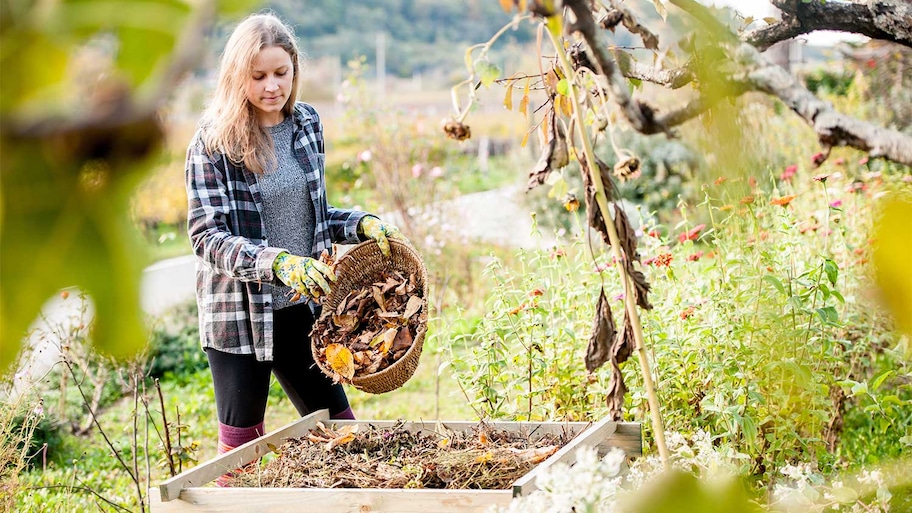How to Remove Yard Waste: 3 Methods to Keep Your Yard Tidy
Send your yard waste down the road or back into the ground


At least three seasons out of the year, figuring out how to remove yard waste can present some challenges and choices. Those choices vary depending on whether you live in an urban, suburban, or rural area. The ultimate goal is to get rid of the grass, brush, and tree trimmings as conveniently and responsibly as possible.
Your local municipality should have some guidance on the services and facilities that are available. Also, many waste collection companies offer removal services. Let’s take a look at three of the most commonly available yard waste removal methods.
How to Recycle Yard Waste
You can do much of this yourself or hire a recycling company that recycles branches and leaves instead of just throwing them away. DIY yard waste recycling could look like mulching leaves in the fall to use in your garden or even making wood chips out of branches and scraps that have fallen off your trees.
1. Gather Your Yard Waste
It helps to gather your yard waste into different types for easier processing. For example, leaves and small sticks can be mulched. Keep larger branches and trimmings from shrubs and bushes together in another container or pile.
2. Turn Yard Waste Into Mulch
Next, break down the yard waste into smaller pieces to speed up the decaying process. For example, leaves and sticks can be mulched together, while you may want to run branches through a wood chipper.
3. Use Mulch for Gardening or Composting
Once your yard waste is mulched, you’re ready to use it for gardening or composting.
How to Compost Yard Waste

Dedicated home landscapers and gardeners, as well as those who don’t have a yard recycling option in their local community, may want to consider composting yard waste at home. This allows you to keep the nutrient-rich compost for your own plants.
Composting Basics
To make compost from your yard waste, you will need three basic categories of ingredients.
Greens: These are nitrogen-rich ingredients. Greens include such things as grass clippings, fruit and vegetable scraps, coffee grounds and filters, eggshells, houseplants, green leaves, and tea bags.
Browns: These are carbon-rich ingredients. Browns include such things as dead twigs, branches, sawdust, wood chips, cotton and wool rags, lint from your dryer, fireplace ash, cardboard, fur, hair, newspaper, and other paper products.
Water: Balance is key here. Too much water or too little water and your compost pile will not work properly.
Compost Your Yard Waste
For best results, your compost pile should have an equal mix of browns and greens.
Designate a compost site in your yard for the compost pile. Building a box or at least three walls can help minimize the footprint of your compost pile and keep it mostly out of sight.
Layer the browns and greens, and make sure you alternate sizes of items as well.
Periodically turn the pile to accelerate the process. Note that if you do not hire a leaf removal service near you, leaves can be used as greens until they turn brown and dry out.
Shred or chop up large pieces, such as tree branches, before including them in your pile.
Cover your compost pile with a tarp if you get a lot of rain. Your pile needs moisture, but it should not get soaked regularly.
Turn the mixture in your pile every couple of weeks to keep it well distributed and composting evenly.
What Not to Compost
When you compost, make sure not to include any of the following, as these things can attract pests or add harmful bacteria or chemicals to your compost pile.
Pet waste
Diseased plants
Insect-ridden plants
Oils or fats
Coal or charcoal ash
Meat scraps or bones
Yard clippings treated by pesticides
Black walnut tree flowers or twigs
Dairy products
Lard
Using Yard Cleanup Services
Some yard cleanup services near you will have programs to recycle the yard waste they collect to keep it out of landfills. Many cities and towns now include yard waste removal in their garbage collection services. Check with your local municipalities to see if they offer yard waste recycling as a component of their curbside garbage collection.
If your city or town does not offer curbside yard waste recycling, then you can hire a private company or take it to a local recycling center. Even if your city does not have a regular recycling program, you can likely dispose of Christmas tree waste through your curbside trash pickup program.
1. Check Yard Waste Removal Policies
Whichever yard waste recycling company you choose, ask what yard debris and waste are accepted. Some items can cause injury, so check the policies and yard waste before loading your waste for drop-off and recycling.
Most recycling services will tell you not to include rocks, in which case you’ll want to research how to dispose of rocks. Recycling services also commonly limit the sizes of branches they can recycle. Many communities and services ask you to put your yard waste into brown paper bags for collection, and while some of these services provide or sell these bags, others ask you to purchase them at a local garden retail center.
2. Gather Yard Waste According to Removal Company Policies
Once you know how the company requires the yard waste to be gathered, separated, and packaged, you can start the cleanup process.
3. Package Yard Waste
Put the yard waste into the containers recommended by the yard waste removal company. If you’re using paper bags, be careful not to leave them in the rain or on wet ground for long periods, as the bottom may fail when you pick up the bags to move them.
4. Dispose of Yard Waste Containers
Depending on the method of collection or delivery you choose, you’ll do one of a few things with your yard waste containers.
Place the yard waste containers out by the road for pickup.
Haul the containers to a receiving center with a truck or trailer.
Rent a dumpster for yard waste and call to have it picked up when it’s loaded.
Schedule a junk removal company to haul away the yard waste containers.
When to Choose a Yard Waste Removal Company
Even if you recycle your yard waste at home, there are things that you still might want to send to the community collection or to a yard waste service. Weeds, for example, should be recycled via a community recycling program since most home composting systems do not achieve temperatures high enough to kill seeds from invasive plants.
Speaking of invasive plants, you should place invasive species, harmful plants such as poison ivy, and diseased plants in the regular trash that goes to the landfill so that you don’t spread problems in your yard by recycling them at home.
Why Is It Important to Recycle or Compost Yard Waste?
Recycling yard waste is vital because of its positive effects on the environment, including the following:
When composting recycled yard waste, aerobic bacteria (bacteria that require oxygen for survival) work with other micro-organisms to break down the yard waste into components that provide key nutrients to the soil, like nitrogen, phosphorous, carbon, potassium, zinc, and others that help plants thrive.
Composted yard waste also helps conserve water through better moisture retention.
If taken to a landfill, anaerobic bacteria (which do not need oxygen to survive) break down the yard waste and produce methane, which is a greenhouse gas 25 times stronger than carbon dioxide.
Methane is the second-most abundantly produced greenhouse gas in the United States, and landfills are the third-highest methane producers in the country after fossil fuel-based power plants and agriculture.
The EPA states that if U.S. citizens recycled all of their yard waste, we would keep more than 35 million pounds of garbage out of landfills each year, dramatically cutting down on the number of greenhouse gasses produced on an annual basis.
DIY vs. Hiring a Pro
Disposing of your yard waste is definitely a DIY-friendly project. Depending on the size of your yard and the amount of grass, shrubbery, and trees you have to take care of, you may spend anywhere from a couple of hours to a weekend or two cleaning up your yard and disposing of the waste it produces. Count on the process taking longer during spring or fall yard cleanup, which requires more comprehensive and thorough maintenance to prepare for the season ahead.
Maintaining larger yards is much easier and more efficient when you have the right tools and equipment for the job. If you have the mowers, trimmers, and hauling capability along with the time, then you can save hundreds of dollars on labor costs, even if you figure in the cost to rent a dumpster. However, if you don’t have the time, desire, or equipment to remove your yard waste, it may be worth looking into lawn maintenance and yard waste removal or the cost of junk removal services.
Allie Ogletree contributed to this piece.
Frequently Asked Questions
Hiring a gardener to clean up the plants, soil, and flowers and remove the garden waste costs between $45 and $75 per hour if you hire a professional gardener. The price may vary depending on the condition of the garden and whether you need additional services to get pests under control, rehabilitate any plants, or adjust soil conditions like the pH or acidity levels.
Yes, it can be good to remove dead branches from trees. Dead branches can lead to rot in other areas of the tree. They can also cause damage if they fall on a house, shed, fence, car, pool, or other structure or property. However, it’s important that dead branch removal is done safely. If the branch is high in a tree or requires a lift or ladder to access, consider calling a professional tree removal company, as they will have the experience and equipment to do the job safely.